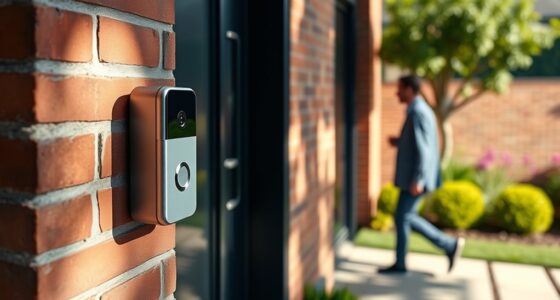A dip switch on your garage door opener allows you to set up unique codes for its operation. These tiny switches let you toggle between on and off positions, helping your remote communicate directly with the opener. When you adjust these switches, you're creating a specific code combination to prevent interference from nearby devices. To guarantee everything works smoothly, make sure the switches on both the remote and receiver match. This simple configuration offers flexibility, but it's important to understand its limitations, which you'll find out more about as you explore further.
Key Takeaways
- DIP switches are small manual switches used for configuring settings on garage door openers through on/off combinations.
- Each switch creates a unique binary code that must match between the remote and opener for operation.
- The dip switch panel is typically located in the remote or receiver's battery compartment for easy access during setup.
- Regular maintenance, including cleaning, is essential to ensure dip switches function properly and avoid interference.
- Due to their limited code combinations, dip switches are less secure compared to modern alternatives like rolling code technology.
Definition of Dip Switches
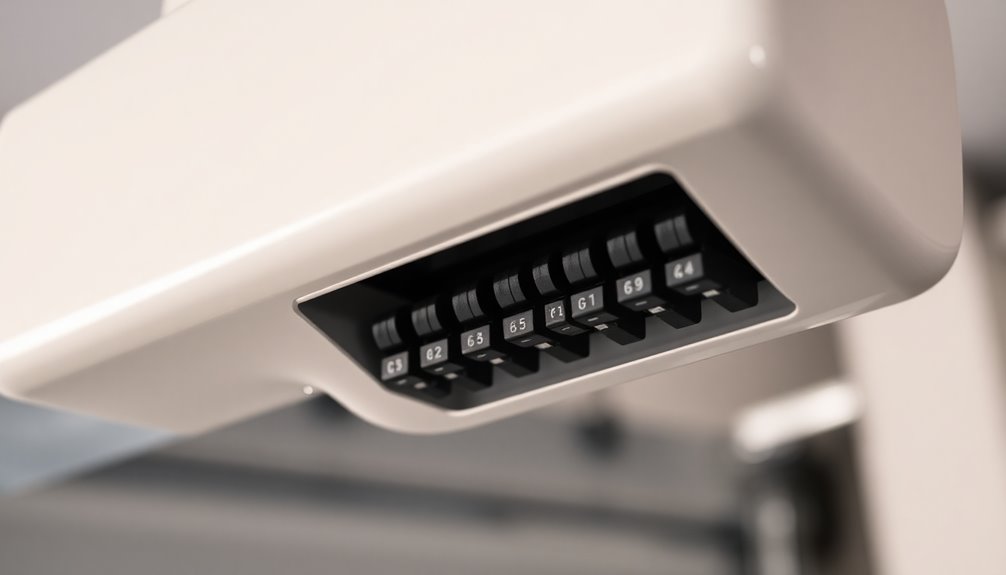
DIP switches are small yet powerful components that play a crucial role in the configuration of electronic devices. Fundamentally, a DIP switch is a dual in-line package switch, featuring a series of switches within a single unit.
You can manually change the configuration of your device by setting each switch to either the "on" or "off" position. These switches are commonly found on printed circuit boards and are used for customization in various devices, from consumer electronics to industrial equipment. They come in different types, including slide and rotary actuators, to fit specific applications. Each switch represents a binary value, allowing you to create unique codes for specific hardware configurations. Additionally, DIP switches are a simple, flexible, and low-cost solution for circuit design.
Components of Garage Door Openers
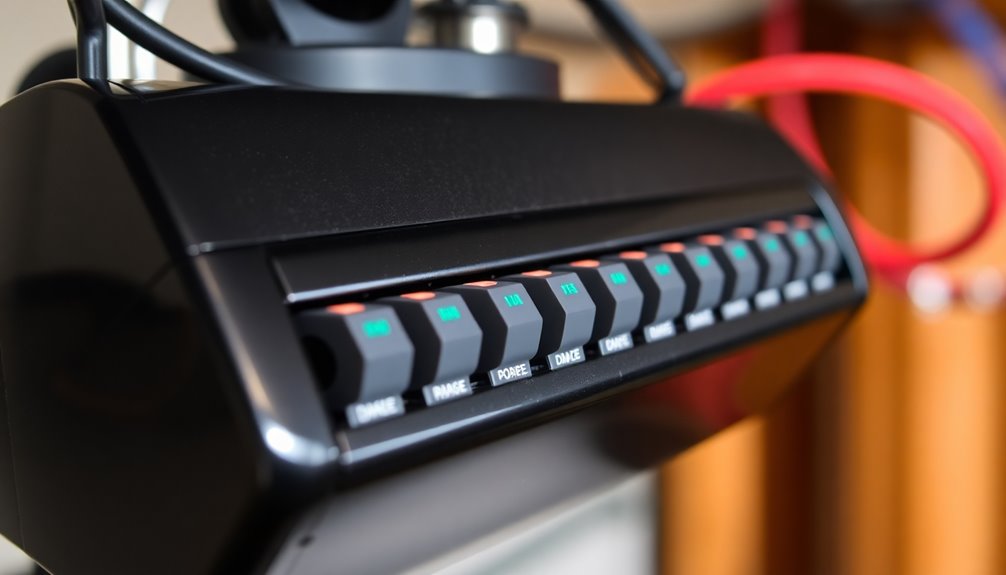
Understanding how dip switches function in electronic devices helps illuminate the broader context of garage door openers.
A garage door opener consists of several key components that work together seamlessly. The motor converts electrical energy into mechanical energy, initiating the door's movement. The main gear and sprocket transmit this motion, while the digital electronic board regulates operations and enhances safety with features like photo-eye sensors. Additionally, the opener's functionality relies on the proper alignment of tracks and rollers, which guide the door as it opens and closes.
You control the opener via the wall control or remote button, sending signals to open or close the door. The opener rail and drawbar connect the opener to the door, ensuring smooth movement.
Each component plays a crucial role, making your garage door system efficient and secure.
How Dip Switches Function
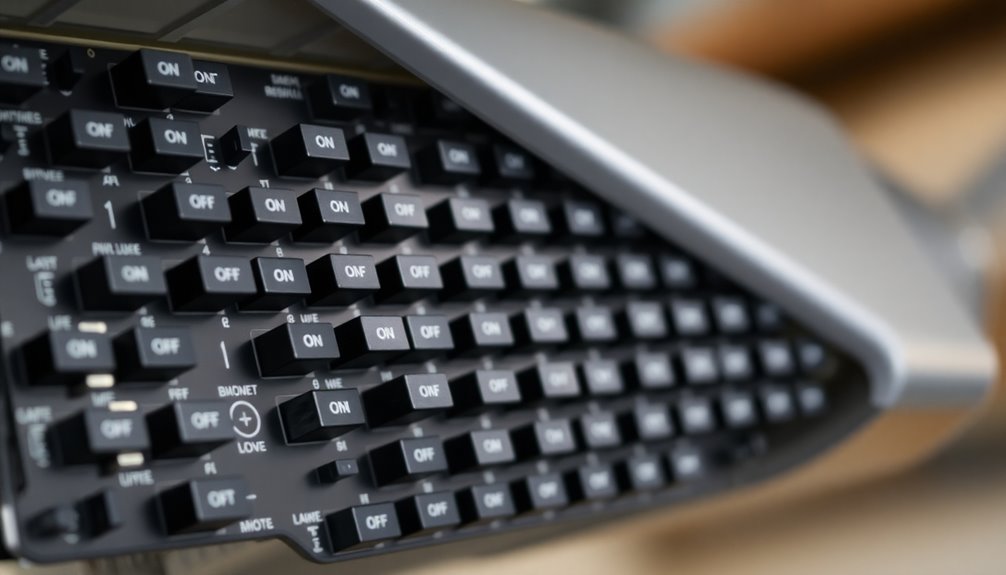
When you look at the inner workings of a garage door opener, you'll find that dip switches play an essential role in its functionality.
These tiny switches are arranged in a row, each representing a binary value of 0 or 1. By setting different combinations, you create a unique code that enables your garage door opener to communicate effectively with its remote control. Programming garage door operators typically involves adjusting the dip switch sequences for compatibility with various transmitters. This process is crucial not only for garage door openers but also extends to other devices, such as ceiling fan remote button functions. By ensuring that the dip switch settings are aligned, users can easily control multiple devices from a single remote, enhancing convenience and functionality in their home. Additionally, understanding how these switches work can help troubleshoot issues, making it easier to ensure reliable operation of your equipment.
Each switch can be turned "on" or "off," allowing you to customize the device's behavior. This setup prevents interference when multiple units are nearby, ensuring that only your garage door responds to your remote.
Setting Up Your Opener
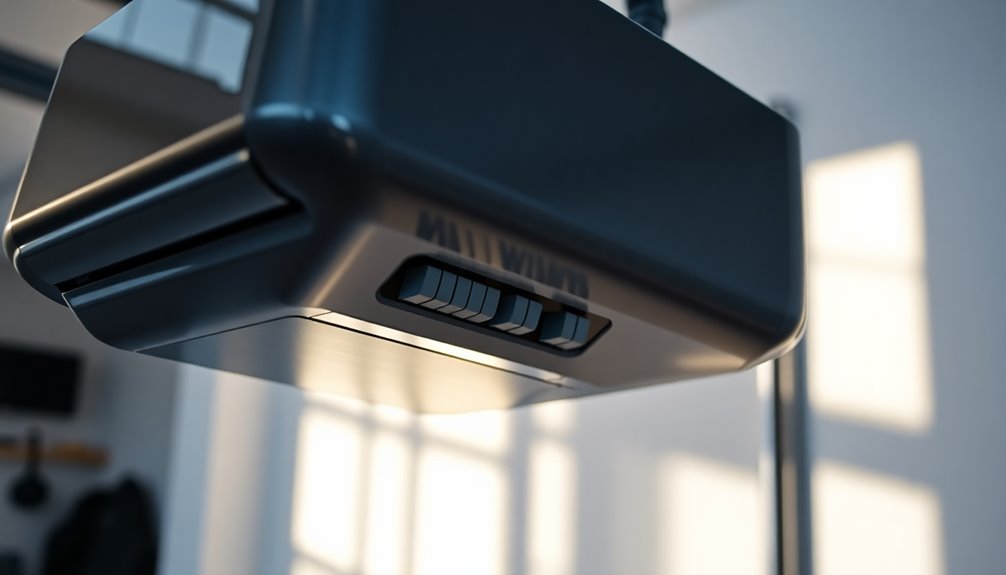
After you've familiarized yourself with how dip switches function, it's time to set up your garage door opener.
Start by locating the dip switch panel, usually found on the back of the receiver or in the remote's battery compartment. Use a screwdriver if needed to access the switches, which can be in "on" or "off" positions, with some having a neutral option. This process is vital as it ensures proper communication between the remote and the opener, particularly when utilizing a specific type of opener that relies on these switches.
Make certain the dip switches on both the remote and the receiver match exactly. To configure them, refer to your user manual for the correct sequence.
Finally, test the opener with the remote to confirm everything works. If you run into issues, double-check the switch positions to verify they're set correctly.
Types of Dip Switches
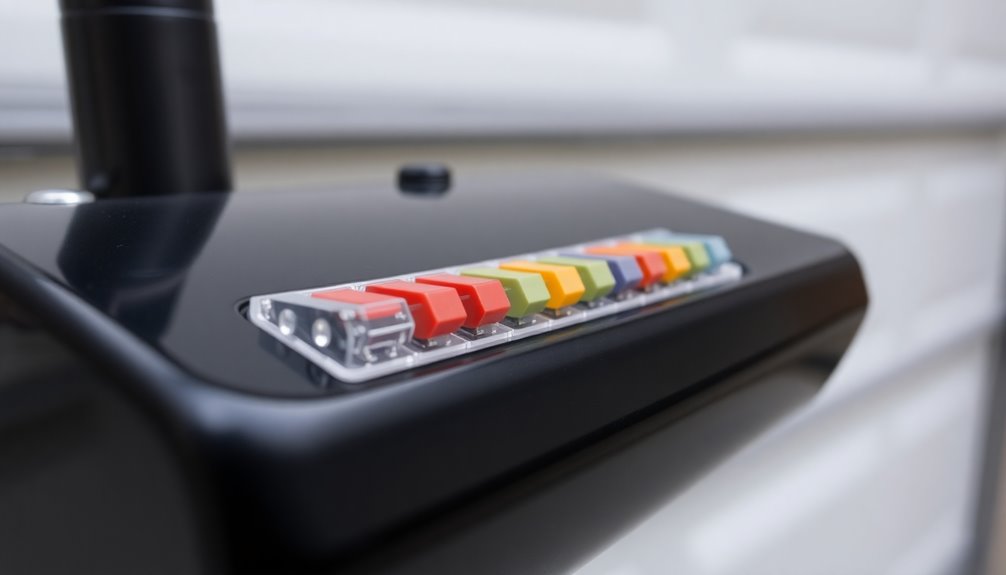
Dip switches are essential components in many electronic devices, including garage door openers.
There are several types of dip switches you might encounter. Slide DIP switches are the standard on/off toggle type, providing a simple binary configuration.
Rotary DIP switches offer precision control and can withstand challenging environments, making them ideal for specialized applications.
Rocker DIP switches function like a seesaw, switching between two positions and are commonly used in various industries.
Finally, specialized DIP switches, like ultra-wave sliding types, serve specific needs in precision instruments and mechanical control systems. Each type offers unique configurations, so understanding these options helps you choose the right one for your garage door opener setup. Dip switches also play a crucial role in ensuring reliable communication between the remote control and the receiver.
Historical Overview
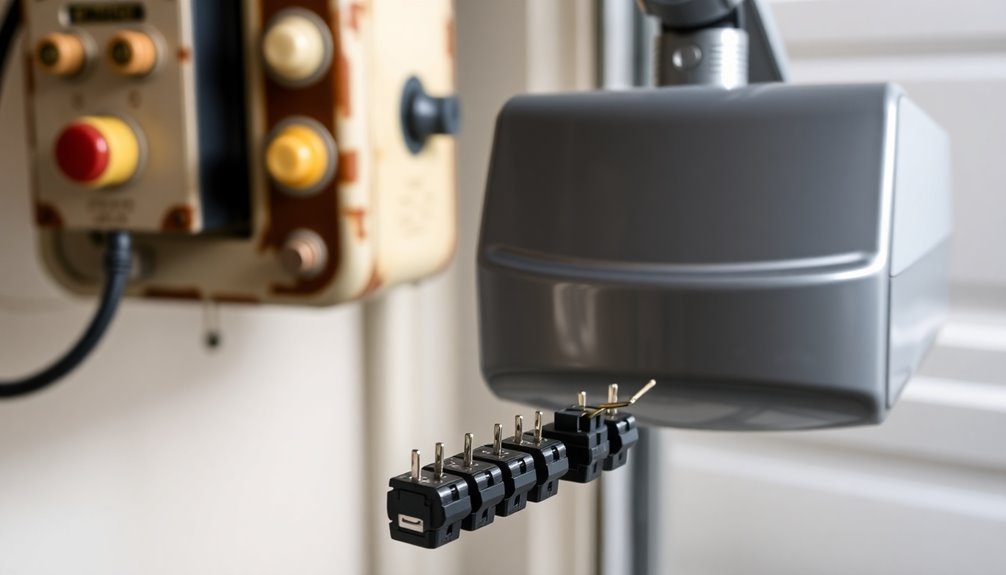
Understanding the various types of dip switches lays the groundwork for appreciating their historical significance.
Introduced in the 1970s, dip switches were electromechanical devices designed for manual adjustments in electronic circuits. Their early adoption in many devices showcased their simplicity and low cost, making them highly versatile. However, as technology advanced, their limitations became apparent, leading to their decline. By the mid-1990s, dip switch systems posed significant security risks, as they were vulnerable to hacking due to limited code combinations. Rolling code technology became a preferred alternative, offering improved security features. While newer technologies have replaced them, dip switches remain a notable part of tech history, particularly in applications like garage door openers, where their configuration capabilities were once essential.
Practical Applications
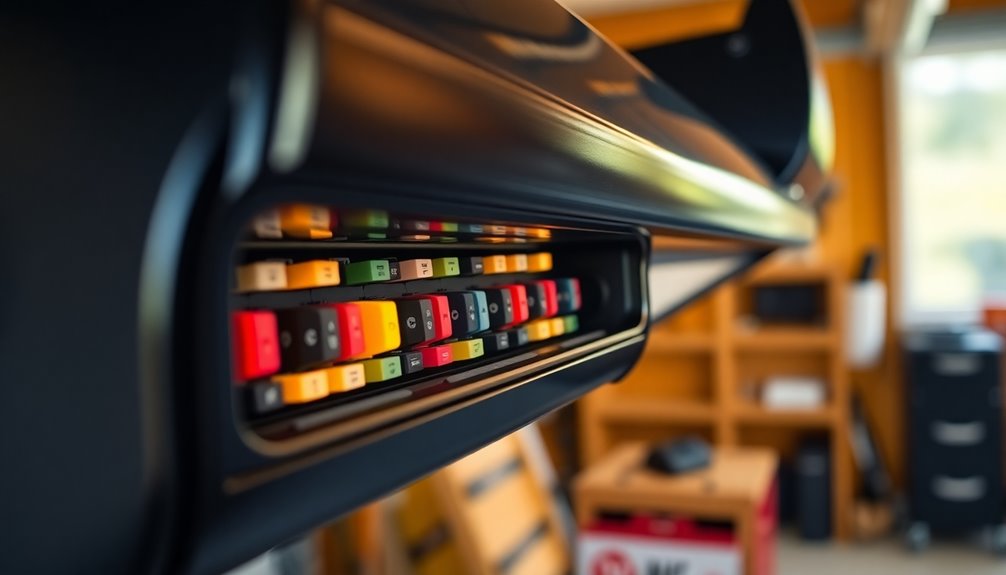
A garage door opener with dip switches offers practical applications that enhance user convenience and functionality. You can easily program dip switches found on the back of your remote control and receiver, ensuring they match to operate effectively. If you have multiple garage doors, some remotes allow you to set unique codes for each, letting you control all doors with one device. This versatility saves time and enhances efficiency. Additionally, utilizing unique codes helps prevent interference from nearby devices, further securing your system. Installation is straightforward, but always refer to your user manual for guidance. While dip switches simplify operation, remember that regular maintenance is essential for peak performance, and keeping the switches in good condition is vital for seamless access to your garage.
Limitations of Dip Switches

Security remains a significant concern for homeowners relying on dip switch garage door openers. These systems face vulnerabilities, like interference from other devices and a limited number of codes—only 4,096 combinations—which makes it easier for thieves to guess your code. Additionally, code grabber devices can intercept your unique code, compromising your security. The unchanging nature of the code also poses risks, as it can lead to unauthorized access if not regularly updated. Configuration can be time-consuming and error-prone, requiring careful matching of switches on both the remote and receiver. Environmental factors and compatibility issues can further complicate performance, making newer technologies with rolling codes a more secure choice. Consider upgrading if security is a priority for you.
Frequently Asked Questions
Can Dip Switches Be Reset if Needed?
Yes, you can reset dip switches if needed.
Start by removing all remote controls and keypads for a clean slate. Then, clear any previous codes by pressing and holding the learn button on your garage door opener.
Adjust the dip switches to match your desired configuration, ensuring they're in the same positions on both the remote and receiver.
After that, test the opener to confirm everything's working properly.
What Happens if Dip Switches Are Mismatched?
Imagine trying to open a treasure chest but finding the key doesn't fit. When dip switches are mismatched, your garage door opener can't communicate effectively.
You might find your remote inoperable, leaving your door unresponsive. Worse, it opens up security risks, allowing unauthorized access.
Troubleshooting becomes a frustrating puzzle, and you might need to reconfigure the switches or even call in a pro to solve the problem and restore your peace of mind.
Are Dip Switches Waterproof or Weather-Resistant?
Dip switches can be waterproof or weather-resistant, but that's not guaranteed for all models.
When you're selecting dip switches for your garage door opener, check their specifications to verify they meet your needs.
If they're not explicitly rated for water or dust resistance, you might want to contemplate alternatives. This will help you avoid potential issues with reliability and functionality, especially in harsh weather conditions.
Always prioritize quality and compatibility.
How Long Do Dip Switches Typically Last?
Dip switches can last for years, much like a well-tended garden or a sturdy bridge.
Their lifespan varies based on how often you use them and the conditions they're exposed to.
If you maintain them well, like regularly cleaning and securing connections, you can extend their durability.
Just remember, frequent use or harsh environments can wear them down faster, so take care to protect them for the best performance and longevity.
Can I Use a Different Remote With Dip Switches?
You can use a different remote with dip switches, but it depends on matching the codes.
First, check the dip switches on both remotes; they need to be set to the same positions for compatibility. If they don't match, the new remote won't work.
Adjust the switches carefully, then test the remote to see if it operates your garage door.
Conclusion
In the world of garage door openers, dip switches are like the keys to a secret garden, revealing smooth and secure access to your haven. They offer a simple yet effective way to customize and protect your opener, ensuring it responds only to you. While they've evolved over time, their core function remains essential in a landscape of technology. So, embrace the power of dip switches and keep your garage door experience as seamless as a gentle breeze.





